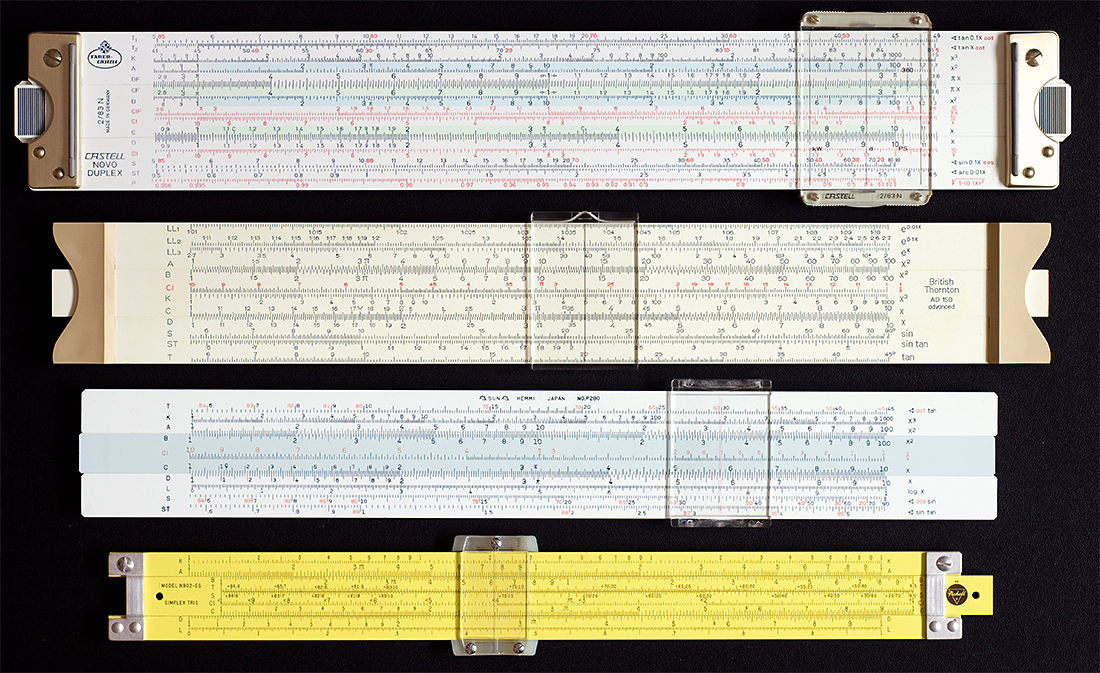
|
'Micscape Lite' Article - Microscopy Enthusiasts Sharing Their Other Interests The Appeal of Slide Rules - For Use and as Collectables by David Walker, UK |
I have a fond affection for slide rules—when studying the sciences at high school and college in the early 70s onwards, they were still a common tool before their rapid demise in the mid 70s when electronic calculators became affordable for all. I bought my first scientific calculator in 1975 (a Decimo 2001E, 'Electronic Slide Rule') and my 'analogue calculator' rapidly gathered dust.
It was only about two years ago that I renewed a latent interest in them and started to explore the many superb resources available, which prompted me to purchase a selection. I wouldn't describe myself as a collector, I bought one example each of styles and of makers that particularly interested me and my 'collection' has stopped at eleven. Making examples from published templates is also fun.
Some of these are illustrated below and, given the wealth of authoritative material available on the makers and models, I just add some comments on why they appeal to me and point out some major features. A selection of Web and other resources are offered at the end which discuss their history, manufacture, use, makers and their models.
Examples of early 70s models
Four typical models spanning a basic to a most advanced example available in the 70s are presented below. The standard slide rule used 25 cm (some 10 inch) long scales— the top one extends the scales. Their relative sizes and weights can clearly vary quite widely, dependent on the model style, materials and number of scales.
The last is half the weight of the first example.

From top to bottom:
Faber-Castell 2/83N Novo-Duplex: Size 38 x 7 cm, 30 scales, plastic. This model is regarded by some as one of the finest slide rules ever made. Its combination of size, build, sophistication of scales offered and attractive use of colour gives a slide rule that impresses! It became more widely known when Cliff Stoll published his excellent article 'When Slides Rules Ruled' in 'Scientific American' May 2006 where it was highlighted. This is the only duplex model of the four shown, i.e. it has an equally comprehensive set of scales on the back (single sided are simplex rules). Used versions of the 2/83N crop up regularly on eBay and new old stock is available.
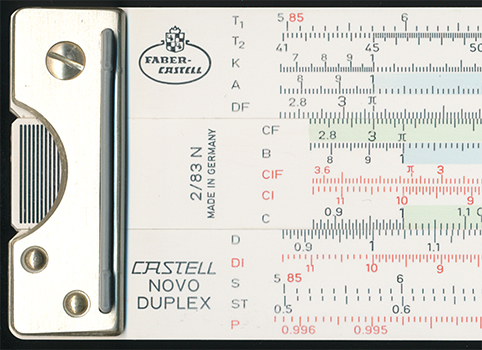
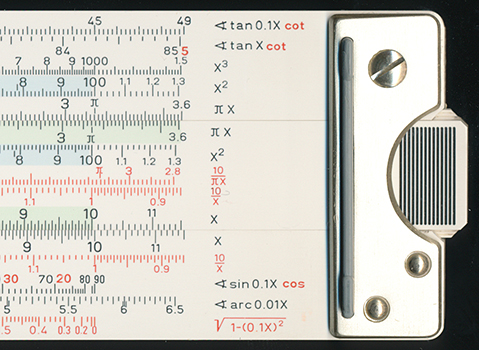
The Faber-Castell 2/83N Novo-Duplex upper face—serious firepower on a slide rule! Rubber strips on metal brackets allow desktop use and a rubberised grip on
ends of slides also aids use. This, like other rules with screwed brackets, allows retensioning of the slide to suit and realignment of upper and lower stators if required.
This rule uses extended scales, i.e. beyond the 25 cm norm, this can aid calculations where an answer 'overflows'.
The typical positions for the C and D scales (1-10-100 scale for x²) as shown in the Hemmi below are replaced by so-called 'folded scales' CF and DF, typically folded around pi or root 10; these are also useful for some calculations.
Studies have shown that a typical 25 cm model's C&D scales can be read to three significant figures to a consistent accuracy of ca. 0.5% across its length. As many writers have commentated, this was more than sufficient to design and build most of man's creations before the advent of electronic computers.
Some rarer specialist rules can command high prices amongst collectors. A Faber 2/84 Mathema which featured advanced maths functions, sold at the time of writing for over $1200 on eBay.
British Thornton AD 150 Advanced: Produced 1973+, simplex, 12 scales, plastic. This is a less sophisticated but typical 'advanced' rule with trig and log-log scales, but my overall favourite in use for handling, practicality and feel, selling for a few pounds on eBay. It was a widely available model when I bought the Hemmi below in the early 1970s. The plastic is thicker than many giving it a stiffness comparable to wooden stock models. The large indented brackets allow a good push pull action to set the slide accurately.
A subtle feature that works well on this rule is the plastic strip rather than metal spring as cursor tensioner. This gives just sufficient tension to maintain cursor alignment but not too much to compress stators and make slide movement stiff. Some rules with metal springs if not perfectly adjusted can give too much tension giving a stiff slide, especially when cursor is near rule centre.
The size and modest number of most likely used scales combined with British Thornton's reputation for precision also visually give the impression of a very crisp easy to read rule, more so I think than the 'busy' Faber above. See Resources below for a paper on the multiple complex steps which this company used to make high precision slide rules.
Sun Hemmi P280: 10 + 3 scales. This Japanese made rule is the original bought in my teens when studying the sciences at high school. Slide rules weren't mandatory, log tables were more commonly used, but some of my fellow students and I did use them, particularly for physics and chemistry, where the three significant figures was more than sufficient. This typical model with a dozen or so scales can handle most of the likely calculations a slide rule would be used for. At the time, a choice of slide rules were still commonly sold in any high street stationers such as W H Smiths and Boots the Chemist (the latter who had their own branded range).
I unknowingly purchased a model which, although now joined with ten more in recent years, I still feel is hard to beat. The use of brackets only on the rear face gives a clean uncluttered look (but are rather fragile if dropped), the plastic is whiter than most giving high contrast scales, the pastel blue of the slide and a comprehensive but not overwhelming range of scales gives what I think is an elegant and easy to use 'sports car' of slide rules.
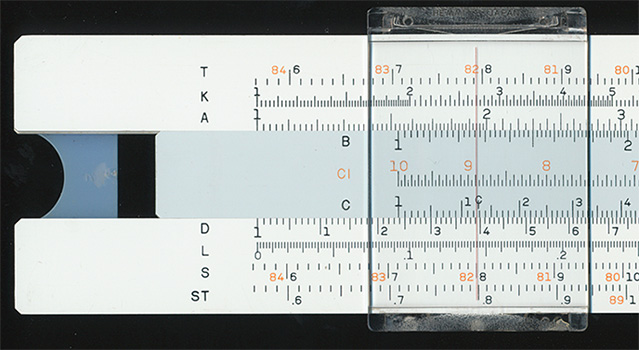
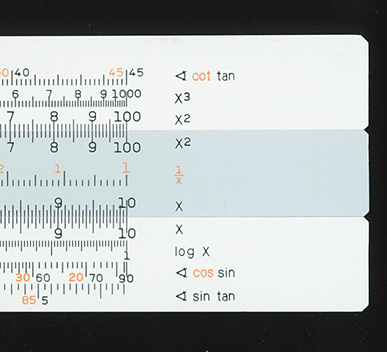
Detail of the Sun Hemmi P281. The scale codes presented on the left were standardised across makers. The simplest rule may just have the A, B, C and D scales and probably the Cl for multiplication and division..
This is an example of a 'self indicating' rule because the function of each scale is given on the right; not all rules featured this.
The slide when closed does not extend beyond the edges of the stock. Some makers extended the slide (e.g.Unique) (or indented the stock, e.g. British Thornton) to allow more precise control, especially when slide was nearly closed.
Functions such as squares, square roots, cubes, cube roots and trig values can be read off for a value of x by just using the cursor. Exponential (or log log) scales are on the reverse of the slide.
Pickett N902-ES: Size 31 x 4.3 cm, simplex, 9 scales, aluminium. Pickett were one of the main US makers and whose later models made extensive use of aluminium to give a lightweight but rigid rule. The 'ES' in the model name denotes their 'Eye Saver' yellow finish (560 nm), the benefits of increased visual acuity of scales and reduced eye strain are described in the accompanying leaflet. (Models were typically available both in traditional white or the yellow).
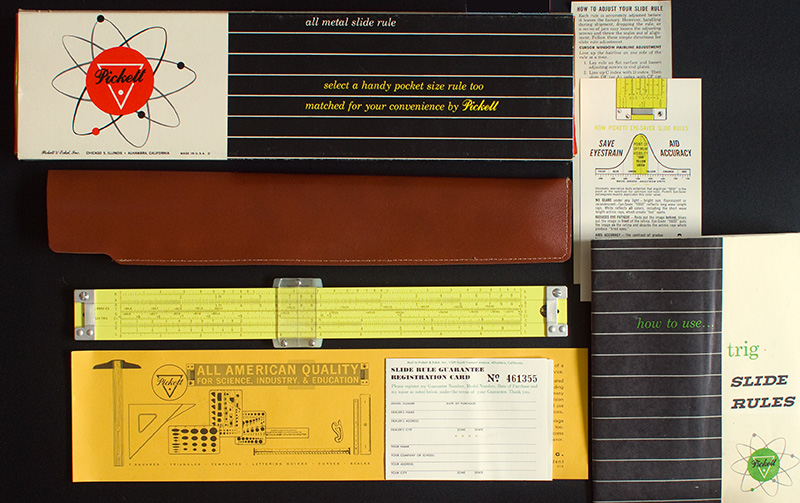
Acquiring 'New in Box' (NIB) examples of models is one aspect that appeals to some collectors. This is the Picket N902-ES 10 inch rule (NIB) bought off US eBay for less than $25.
I've only bought two NIB models. I prefer to acquire the well used but still fully functional models (preferably with its box and manual albeit likely tatty) where they can often attract barely a few pounds. A well used example, often inscribed with owner's name, can be part of their appeal.
Examples of earlier wooden / bamboo models
Three typical mid 20th century or later wood based slide rules and one bamboo example are shown below. When handling wooden/bamboo slide rules, there is an immediate impression of rigidity, not always experienced with some later lightly built plastic rules, or some of the largest plastic rules that can sag somewhat under their own weight.
The earlier rules engraved or stamped the scales on the wood (I don't possess an example); the examples shown adopt a variety of scale manufacturing methods using celluloid attached to the stock. Even for the cheapest school rules, precision scales were of course vital to be of use.
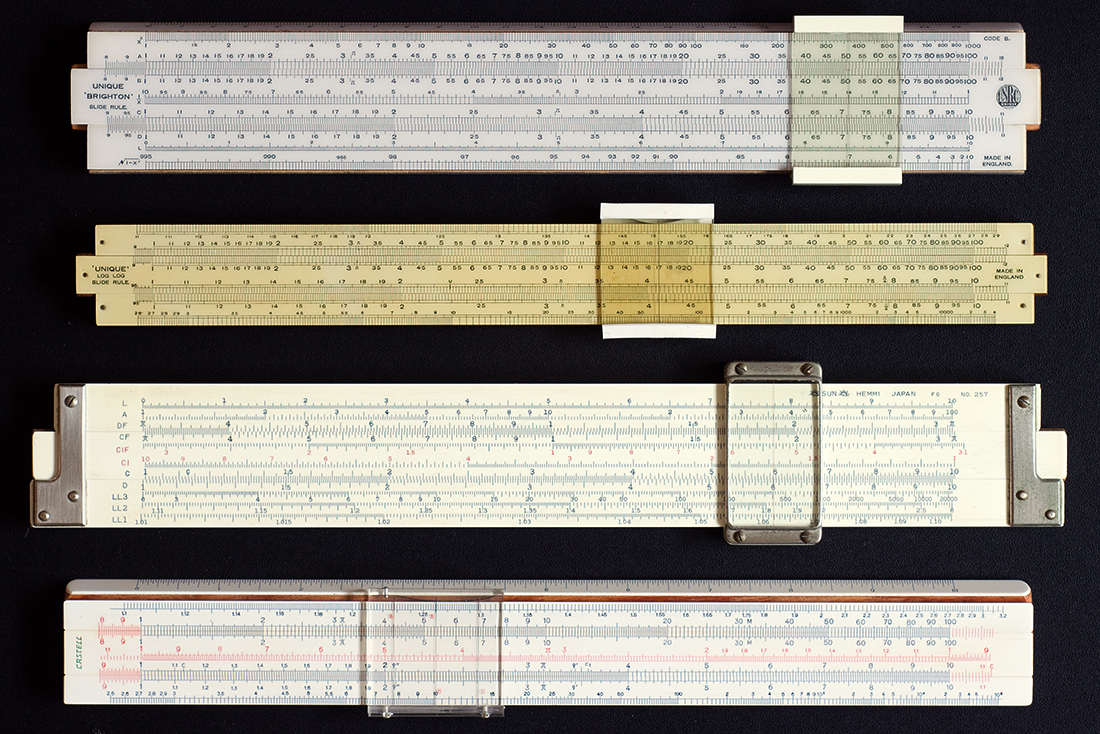
From top to bottom:
The first two were made by the British company Unique based in Brighton. The first is the 'Brighton' model with mahogany stock, the most sophisticated they made; the second is their basic 'Log Log' model. Both use a scale method unique to the company of celluloid strips protecting printed paper scales. The 'USRC' logo dates the Brighton to 1955 or later.
The third is a Hemmi 257 which I bought partly because it was an example of their use of bamboo, a self lubricating material. The end sections have a very distinctive look of bamboo and is my prize possession for a reason I'll return to later. Hemmi used two letter date codes, this one 'FG', which allows it to be dated to July 1955 using published lists.
The last is a Castell, the 1/92 made of pear wood with a metric rule on its upper edge, which was quite a common feature. Unlike the Unique models, both the Hemmi and Castell use engraved scales on the celluloid itself bonded to the stock.

End views of the four slides rules comparing design features of cheap to more expensive models. L to R: Unique Log Log, Unique Brighton. Faber-Castell 1/92 and Sun Hemmi 257.
The Unique Log Log, a cheap model, has no tongue and groove and relies on the celluloid strips overlying scales for placement.
The first three from left to right are simplex rules, they only have scales on the front face and the cursor designs reflects this.
The Hemmi 257 far right is a duplex with a bamboo stock with the distinct
texture seen in end view.
Metal strip inserts for stability and also as a base feature on the Castell and were typically used in 'closed rules'. Others used end brackets without a base like the Hemmi, an example of an 'open rule'.
The first three have so-called 'railway track scales', a feature I like as keeps each scale distinct on a busy rule and can aid reading off values. It's not a design seen on most later rules, possibly because of the added complexity of manufacture if engraved scales rather than printed.
Pocketability
The 25 cm scale was used in typical 'full size' models but a variety of reduced scale models were available for pocketability. The German Reiss 3212 model below has a typical 12.5 cm scale, this has a basic set of functions but some models crammed a lot of features into the format, e.g. the electronic rule below. I'm not sure if it caught on elsewhere, but many US models (both pocket and 25 cm) were available in leather holsters for the belt—the analogy
with the Wild West hasn't escaped commentators on the slide rule's heyday—quickest on the draw maths perhaps for competing engineers tackling a thorny problem! See Dan Winters' delightful article in Discover Magazine, 'The First Nerd Tool'.

Reiss 3212 pocket model, plastic with 12.5 cm scales. The Picket N600-ES 5 pocket model became famous as 'the slide rule that went to the moon' and was used on five Apollo missions. Examples in the Apollo themed presentation box are very collectable (but beyond my budget!). The original used by Buzz Aldrin on Apollo 11 sold for $77 675 in 2007.
Cylindrical and circular rules - three examples
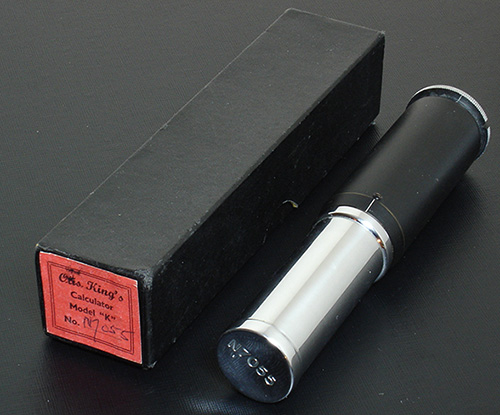 The slide rules illustrated so far are linear with typical 25 cm (or 10 inch) scales. For greater precision, models with linear scales of 50 cm or more were available but they can start to become impractical. Wrapping the scales spirally around a cylinder was adopted by some makers and I own one very common example, the 'Otis King Calculator', a British model whose production spanned from ca. 1923-1972 (shown
right, model K, type B, serial no. N7055).
The slide rules illustrated so far are linear with typical 25 cm (or 10 inch) scales. For greater precision, models with linear scales of 50 cm or more were available but they can start to become impractical. Wrapping the scales spirally around a cylinder was adopted by some makers and I own one very common example, the 'Otis King Calculator', a British model whose production spanned from ca. 1923-1972 (shown
right, model K, type B, serial no. N7055).
It has scales equivalent to a 66 inch linear rule, although this is modest compared with some. The Fuller rule used a much larger cylinder with spiral scale 42 feet long. The Thacher rule used 20 linear scale bars mounted on a rotating cylinder scales equivalent to a ca. 60 foot linear rule. These are very collectable and attract healthy prices.
The Otis calculators are readily available on UK eBay and a good boxed example of a common variant can be acquired for ca. £20+. Mine lacks the original leather case. They have been widely studied; dating the serial numbers and styles throughout their production attracting particular interest.
Perhaps familiarity in use will attract greater appreciation and it's a fascinating collectable, but I much prefer to use a linear rule where the complete scales are immediately visible. The extended scales can require 'hunting' to set a given value and don't feel that the single hand twisting action to set a precise value is as ergonomic as the linear rule where there's potential for both hands to work in opposition and hands kept off the scales. The 'K' model illustrated is also only capable of multiplication and division cf the multi function linear rules. Writers have remarked that the extended scale does not consistently give an additional significant figure cf the typical 25 cm linear rule.

The calculator is ca. 10 inches fully extended and ca. 6 inches closed, diameter ca. 1 inch. A single cycle scale is on the left and a double cycle on the right. Manipulation of the sliding black cursor and rotating one scale with respect to the other provides the calculation. The scales on this example are coated paper (later models used celluloid). Considering in use the scales are being handled all the time (unlike a linear rule), possibly in a grubby working environment, this example as do others, survive well. White scales on a black background were also available.
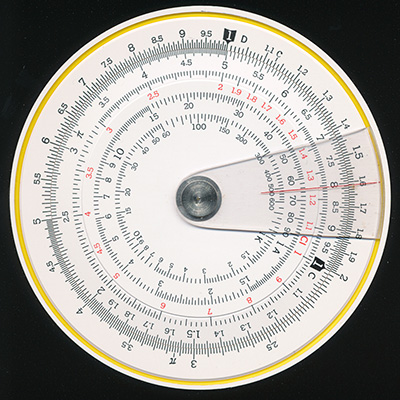 Circular rules offered a more portable design and also much larger scales than a linear model if the scales were spiral. A wide range of specialist rules were, and some still are made, and used
today for example in aviation. A very modest Time
Life branded Concise 28N model (a Japanese maker still offering rules), shown right; most more advanced examples have been outside my budget to date. One of the finest models was the Faber-Castell 8/10 12 cm diameter, it's a stunning looking rule with subtle use of colour and advanced scales.
The Gilson Atlas was ca. 8 inches in diameter, one type had a 46 foot spiral scale equivalent to a linear rule with a 71 foot scale! My homemade example of the Atlas from a downloadable template is shown below.
Circular rules offered a more portable design and also much larger scales than a linear model if the scales were spiral. A wide range of specialist rules were, and some still are made, and used
today for example in aviation. A very modest Time
Life branded Concise 28N model (a Japanese maker still offering rules), shown right; most more advanced examples have been outside my budget to date. One of the finest models was the Faber-Castell 8/10 12 cm diameter, it's a stunning looking rule with subtle use of colour and advanced scales.
The Gilson Atlas was ca. 8 inches in diameter, one type had a 46 foot spiral scale equivalent to a linear rule with a 71 foot scale! My homemade example of the Atlas from a downloadable template is shown below.
The plastic simplex Concise 28N shown right (8.4 cm in diameter) was a promotional example from Time Life and uses circular scales. The outer are comparable to a ca. 21 cm linear rule, but become less precise as move towards the centre (innermost scale ca. 12 cm).
A Russian KL-1 circular rule with a pocket watch type design is shown below. Its ca. 3.7 cm diameter outer scale makes it equivalent to a ca. 11.6 cm (4.6 inch) pocket linear rule. They are well made, very tactile and a pleasure to use and make excellent unusual presents for the 'techie folk' amongst family and friends (this example was a present to my brother for Christmas 2012.) A range of makers made rules to this design, including the English maker Fowler, with their 'Magnum' models being particularly impressive. See the page devoted to the watch style of slide rule at the International Slide Rule Museum.
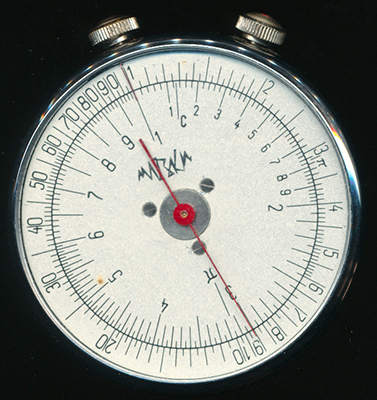
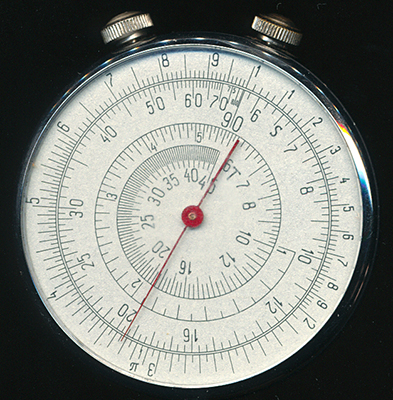
Russian KL-1 pocket watch style slide rule. Overall diameter 5 cm. There are log scales one side and trig. scales on the reverse so can perform the more common functions of a slide rule. One knob rotates the dial on the log side with respect to a small fixed needle (seen just below lefthand knob aligned with '1'). The other knob rotates the red needle. They are regularly available on eBay, this one was bought from the Ukraine for £14 with original box and Russian instructions (dated 1969). (English instructions are available online, they are easy to use.)
Specialist rules - two examples, a 'chemical' and an 'electronic'
A wide range of specialist rules for a variety of trades and professions were made and are well documented. Many were less common than the standard rules and can attract higher prices.
Electronic MK rule. IWA 0272, German made for the Dutch company De Muidekring N.V.: This belongs to my brother Ian, an electronics engineer. In his teens, being a keen electronic hobbyist, he won it in a competition run by a components supplier seeking a catchy sales line. We missed the top prizes but were chuffed with any prize. We still recall the corny sales line entered, 'Don't Bypass BuyPack for the Best Buys' !

The face showing the electronic scales of the IWA 0272. It is a duplex pocket slide rule with 20 cm scales but packs in a lot of features. (The other face has typical maths functions.) The slide is a plastic strip sandwiched between two riveted faces; this design allows additional slide scales to be displayed, although gives a rather stiff feel. The rule employs a good use of limited colour and scales are crisply presented —a pocket rocket! The company IWA still makes specialist rules.
Sun Hemmi P257 'Chemical rule'. The manual states 'especially designed for use by chemical engineers'. My own work background is in the petrochemicals industry and was keen to own an example. The more advanced models such as this one, aren't that common and often fetch three figure sums, but was lucky to acquire one on UK eBay for a modest two figure sum, possibly because the box was incomplete and lacked the original manual. As remarked earlier it was also my example of a rule with bamboo stock.
It's a fascinating collectable but as a chemist I'm unsure how practical or widely used some of the features on this type of rule may have been with its 52 elements, 18 functional groups and given addition is needed to work out molecular weights, requiring calculations away from the rule. The molecular weights of compounds in use would be readily to hand (container label, catalogue, 'Rubber Handbook') and for atomic weights a periodic table would never be far away. Conversion factors between temperatures, pressures etc would be to hand if required and using a mix of pressure units or temp. scales would often be limited in a given lab / industrial environment to avoid mix ups.
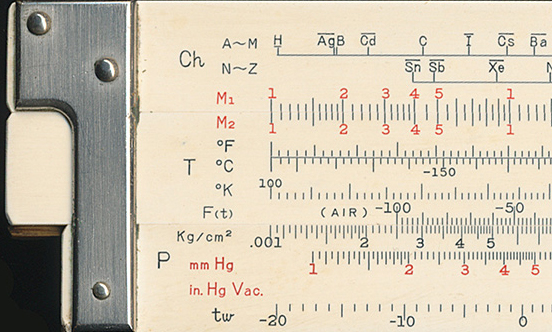
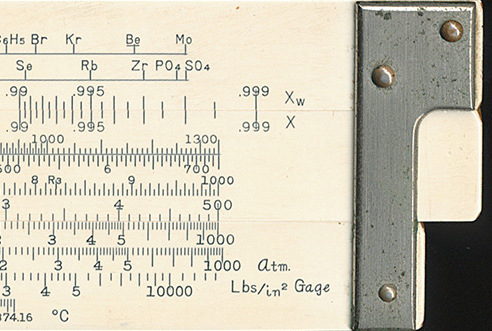
Detail of the scales for the chemical engineer (or chemist) on the Hemmi 257. 25 cm scales, celluloid on bamboo, duplex scales. Placing the cursor over an element or chemical group on the upper scales allows the atomic / molecular weight to be read on the D scale on other side. They are arranged in order of their significant figures, i.e. H - Ag - Cd - B equivalent to 1008 - 1079 - 1081 - 1124 with Mo on far right - 9594. The position and presence / absence of a bar for each indicates decimal point location.
A final thought - go retro and/or make one!
Going retro is becoming common, notably in hi-fi where the keen eared may appreciate the analogue sound to digital—valve amplifiers, vinyl LPs and analogue radios have made a big comeback. Slide rules, the analogue calculator, are cited by some as being obsolete, but why not a gentle revival to complement calculators (slide rules aren't designed to add or subtract of course). As often remarked, slide rules make the user think about their calculations, they only give the
significant figures
and the decimal point has to be quickly determined. Many of the calculations we do daily are simple multiplication and division without the need for the 8 decimal places a typical calculator will deliver, e.g. currency conversions, proportions, percentages or calculations for buying items around the home etc and can be readily done with little expertise on the main scales of a basic slide rule, a 5 inch pocket model could suffice.
They're fun and an ideal way for students to really learn about the power of logarithms and to understand their calculations. A slide rule user may attract a bit of attention, perhaps even start a conversation or two if used in public. A youngster may ask "what is that?", some of a certain generation may comment, "Hey you're using a slide rule, I haven't seen one of those for a while!".
Or make one: There's no need to buy one for a user of any age to get started. It's fun and instructive to make a slide rule from one of the templates available online. The rule below was made in a few minutes from a print out, scissors and two pieces of clear adhesive tape. Good enough to appreciate how they work with a number of functions offered.

A stiff paper slide rule made from the template in Cliff Stoll's Scientific American article.
The above is a fun demo' design but with modern printers and some craft and/or wood making skills, some very fine slide rules can be made, linear and circular models in particular with a range of templates available. There's a good selection at the International Slide Rule Museum website, including an ingenious circular rule using a CD case by Ying Hum, see below. After a buying or making a slide rule, if the original manual isn't available online (many are), there's a superb illustrated tutorial on slide rule use (pdf download) offered on the Oughtred Society website (see Resources).
For a more ambitious homebuild project, some enthusiasts have built fully working replicas of large cylindrical rules like the Thacher.
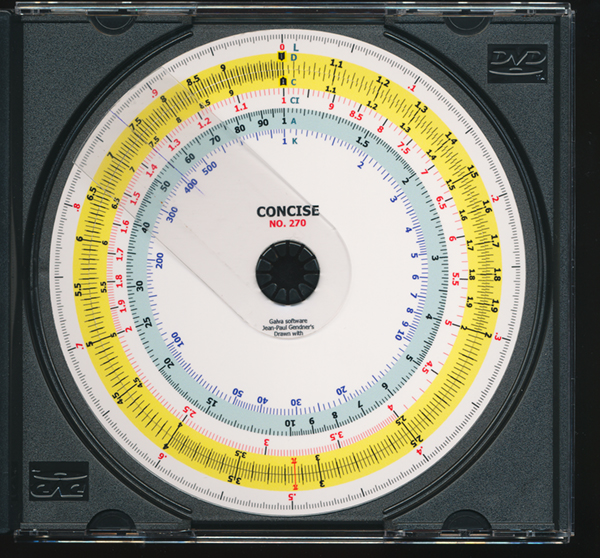
The above, based on the Concise 270 model, was made to Ying Hum's design using an inkjet printer, stiff glossy photo paper and clear acetate for cursor. Using his supplied high quality scales and a compass cutter for central holes as well as borders gives a high degree of concentricity between the two scales and cursor, producing a precise and usable slide rule. The large central pivot reduces the wear cf smaller fastenings that can introduce errors with wear.

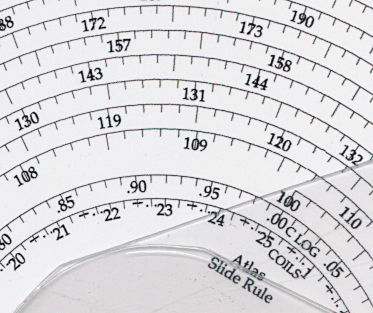
My homemade example of the Gilson Atlas Model III 8 inches in diameter, extending the ingenious DVD case design of Ying Hum (the flat base with pivot was cut out of case) and using a superb template based on the Model III by Wayne Harrison available to members of Yahoo 'The International Slide Rule Group' (in Files). The main scale is a single spiral scale, unlike the circular scales in the Concise model above. Printed on glossy stiff photo paper using an old Epson 740 1200 dpi inkjet printer (much for better for hi-res work than my 600 dpi modern LaserJet) with acetate sheet cursors. A compass cutter cuts the centre and border for a neat, accurate working rule. The originals had a slipping clutch for the cursors, as during a calculation the cursors have to be held in position relative to each other. With above design the DVD pivot holds the cursors firmly and the card is moved with respect to cursors avoiding need for a clutch.
Scale detail shown right. These rules are capable of at least four significant figure results, i.e. equivalent to four figure log tables.
OK, I'll get off my slide rule soapbox!
Comments to the author David Walker are welcomed.
Note: The author's main interest is microscopy so it was inevitable that my modest collection would be closely examined under a stereo microscope to see what more I could learn about them. The earlier studies were shared in the web article 'Some Typical Slide Rules Under the Microscope' but it is hoped to share an article with more extended studies in the August 2013 issue of 'Gazette' the annual magazine of the United Kingdom Slide Rule Circle.
Acknowledgements
Thank you to Ying Hum for sharing his ingenious design of circular slide rule with CD case as holder / pivot as hosted on Mike Konshak's splendid International Slide Rule Museum website. Thanks also to Wayne Harrison for sharing his Gilson Atlas design on the Yahoo 'The International Slide Rule Group' website.
References and a Selection of Resources
Books
Dieter von Jezierksi, Slide Rules. A Journey Through Three Centuries, Astragal Press, 2000, 126pp. This is a superb book with B/W illustrations, which discusses
and illustrates all aspects of slide rules and their history. Includes a good historical survey of main makers and their models.
The Oughtred Society Slide Rule Reference Manual, 2010 second edition, 102pp. Sumptiously illustrated in colour, available as a high quality softback from the Society, but they also generously offer a version as a free Acrobat file format download from their website.
Florian Cajori, A History of the Slide Rule and Allied Instruments, Astragal Press, 1994. A high quality reprint of Cajori's now classic account published in 1910.
Websites / downloadable resources
The Oughtred Society "Dedicated to the preservation and history of slide rules and other calculating instruments". This site has a wealth of its own resources, including the manual above, a tutorial of slide rule use and also access to older papers in its Journal. Its own links page is also carefully categorised and a good starting point for exploring the many resources online including online museums, sellers of new old stock and used slide rules.
Rod Lovett's Slide Rules In addition to his own resources, he also offers a powerful search engine that can check for articles/papers in the major slide rule publications on any topic and also a search engine for checking prices that models sold for at auction. Any of the makers mentioned above as keyword will bring up resources, also e.g. 'chemical' will show papers on this type of specialist rule.
An Interview with Vintage Slide Rule Collector Mike Konshak, Collectors Weekly, November 2008. A fascinating interview for this magazine by Maribeth Keane. Mike Konshak founded The International slide Rule Museum website.
Colin Barnes, Manufacturing "British Thornton" Slide Rules, Proceedings of the 11th International Meeting of Slide Rule Collectors, October, 2005, pp.31-47.
A fascinating illustrated paper which describes the typical complex stages involved in making a high precision slide rule. (Hosted on Rod Lovett's website.)
Published in the December 2012 edition of Micscape.
Please report any Web problems or offer general comments to the Micscape Editor .
Micscape is the on-line monthly magazine of the Microscopy UK web site at Microscopy-UK
©
Onview.net Ltd, Microscopy-UK, and all contributors 1995
onwards. All rights reserved.
Main site is at
www.microscopy-uk.org.uk.